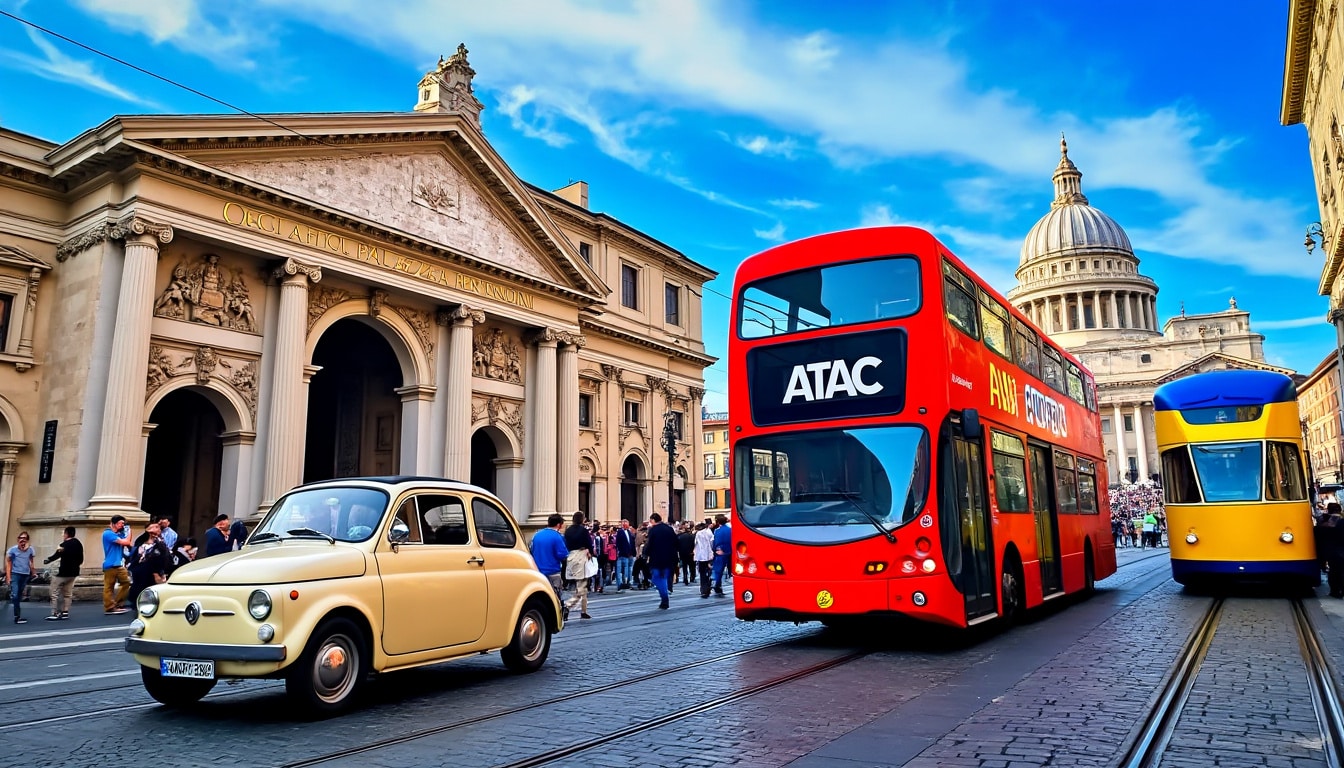Rome, the eternal city, is not only a treasure trove of historical sites and cultural riches, but it also presents a labyrinth of streets and a complex transportation system. As travelers flock to wander the cobblestone pathways and explore ancient wonders, understanding how to navigate the city’s transport network becomes crucial. From the intertwined routes of trams and buses, overseen by ATAC and Roma Trasporti, to the iconic Vespas buzzing through traffic, this guide sheds light on how visitors and locals alike can efficiently traverse this captivating city. Whether you’re arriving from one of Rome’s major airports or planning to roam the picturesque streets of Trastevere, having the right transport knowledge is key to enhancing your Roman adventure.
Exploring Rome by Public Transportation: Navigating with Buses, Trams, and the Metro
The extensive public transportation network in Rome is a testament to its commitment to connectivity and accessibility. Managed by ATAC, the city’s buses, trams, and metro form a seamless web that connects key tourist spots like the Colosseum, the Vatican, and the buzzing Piazza Navona.
The buses offer broad coverage, reaching neighborhoods where the metro might falter. With over 350 bus lines, they are convenient, yet travel times can be unpredictable due to the bustling streets of Rome. For clarity on routes and schedule, the Moovit app provides real-time updates, ensuring that you remain on track without a hitch.
For those seeking a smoother journey, the tram system presents an excellent alternative. Trams glide past significant sites, such as the vibrant district of Trastevere and the modern EUR neighborhood. Line 8, in particular, offers scenic views, ferrying passengers between Piazza Venezia and Trastevere with ease.
Finally, the Metro, though not expansive as some European counterparts, is crucial for rapid transit across the city. Currently featuring lines A, B, and the under-construction C, the metro links crucial transit hubs like Termini Station and suburban areas. With a 72-hour pass costing €18.00, it’s a cost-effective choice for tourists planning to visit multiple locations.
With affordability at the forefront, a single bus or tram ride costs €1.50, valid for 100 minutes with transfers. Tickets can be purchased at Metro stations, Tabacchi shops, or via the MooneyGo app.

While the system is robust, navigating it can be a bit daunting initially. It’s recommended to have a travel card or mobile app handy for seamless ticket purchases and journey planning. Moreover, plan trips outside peak hours to avoid congestion and enhance your transport experience.
The Pros and Cons of Public Transport in Rome
As with any metropolitan public transport, Rome’s system has its highs and lows:
- 🚍 Pros: Economical travel, wide coverage, excellent for long stays.
- 🛑 Cons: Irregular timings, potential crowding, limited metro lines.
Ultimately, public transportation is a convenient and economical means for exploring the city’s depths. However, flexibility in your travel plan can be beneficial, allowing for adjustment around the inevitable delays or changes.
Getting Around by Taxi and Ride-Sharing: Roma’s Alternative Routes
For travelers prioritizing comfort and convenience over cost, taxis in Rome offer a straightforward mode of transport. Official white taxis are metered and reliable, ensuring a hassle-free ride. However, fares can vary, with night surcharges and additional fees for luggage and extra passengers.
A typical ride within the city will range from €8-€15, while airport connections are fixed at €55 from Fiumicino and €40 from Ciampino into the city center. These taxis can be hailed on the street or reserved via apps like Taxi Roma or Uber Rome. Note that while Uber operates in the city, it functions as an aggregator—offering traditional taxis as well as luxurious options through Uber Black.
Ride-sharing opportunities might not be as prevalent as in other global cities, but services like Michaelia Car Sharing are available for those looking to travel beyond the city center. Offering short-term rentals, these cars are perfect for brief excursions, whether it’s a short drive to a quaint vineyard or a longer venture into the Italian countryside.
Considering the variables of cost, availability, and potential traffic, taxis and ride-sharing present an excellent alternative for specific scenarios, such as late-night journeys or when laden with luggage.
| Transport Option | Typical Cost | Best For |
|---|---|---|
| Taxi | €8-€15 within city | Comfort and convenience |
| Uber Black | Variable | Luxury rides |
| Michaelia Car Sharing | Rates based on time & usage | Self-driven short trips |
Whether through Taxi Roma hailing or using the Moovit app, travelers have a variety of options to tailor their commutes. Just remember, keeping an eye on emerging traffic conditions is a smart move in busy cities like Rome.
Embracing Rome’s Cultural Essence: Exploring By Vespa, Scooter, and Bike
For those who seek more than just a ride but an experience that echoes the Italian dolce vita, Rome provides alternatives like Vespa, scooters, and bikes, offering a distinctive, exhilarating way to roam its streets.
Significant in popular films as an emblem of Italian culture, the Vespa remains a classic option for the daring traveler. Handling the dynamic traffic of Rome, however, requires confidence and awareness. Legal stipulations require a valid license and helmet, ensuring safety amidst the chaos.
Rental services are plentiful, and platforms like Ride2Rome make booking effortless. Costs can range based on the duration of rental, but expect prices to start around €30 per day, naturally with necessary add-ons like insurance.
Meanwhile, bikes and e-bikes offer an eco-friendly, leisurely way to see the city. Services like Rome Bike Rentals provide a variety of options catering to different experience levels and preferences. Due to Rome’s characteristic seven hills, e-bikes are recommended for those seeking easier rides uphill without sacrificing the joy of cycling. Key biking locales include the scenic Appian Way and paths along the Tiber River.
Nevertheless, riding any form of two-wheeled transportation through Rome’s cobbled streets can be challenging, especially during peak traffic hours. Moreover, theft prevention measures such as locks cannot be overstated, ensuring your bike or scooter remains secure.
Exploring Rome from the vantage of a Vespa or bike enriches the traveler’s connection with the city, blending freedom with immersive sightseeing. This iconic mode of transport will surely etch an unforgettable memory in your Roman holiday.
Why Choose Two-Wheel Transportation?
- 🏍️ Cultural Immersion: Feel the Italian lifestyle firsthand.
- 🚴 Flexibility: Navigate through narrow streets with ease.
- 🕒 Time-efficient: Avoid long waits in traffic and arrive quickly.
Arriving in Rome: Airport Transfers and First Impressions
For many, the journey to Rome begins at either Fiumicino, also known as Leonardo da Vinci Airport, or Ciampino Airport. Both are well-equipped to funnel you into the heart of the city.
From Fiumicino, the Leonardo Express train offers seamless transit into central Rome, with a journey time of just over 30 minutes for €14. Alternatives like airport shuttle buses and taxis provide options for varied budgets and convenience levels, as private rides are pegged at a higher price point but offer a relaxed, direct service.
Arriving at Ciampino, a similar choice awaits: shuttle buses, direct trains, and taxis stand ready to cater to passengers. Those considering an Uber in Rome will find it integrates traditional taxis into its service, ensuring consistency in pricing and service standards.
Beyond cost and speed, comfort and accessibility should guide your airport transfer selection. Taxi Roma offers a straightforward, flat-rate ride for those preferring door-to-door service, creating a stress-free arrival experience.
Exploring luggage storage options along the way can also streamline your trip, providing pit stops between accommodation and attractions. Travelers are encouraged to review luggage storage tips for further ease.
Choosing the right airport transfer can set the tone for a smooth entry into the city, offering the perfect prelude to your Rome adventure.
Keeping It Light and Agile: Using Electric Scooters in Rome
One of the newest trends to hit Rome’s transportation scene is the rise of electric scooters. While their convenience is undeniable, they have stirred contention among residents and city planners due to safety concerns and often careless parking practices.
Electric scooters present an affordable, agile way to navigate Rome’s bustling urban landscape, especially appreciated during the temperate evenings. Services like Lime and Bird offer user-friendly applications that make finding and unlocking a scooter a breeze. However, users must be over 14, and helmets are now required by law, aimed at increasing safety.
Before hopping onto a scooter, it’s crucial to acclimate to the city’s traffic patterns. Busy intersections and cobblestones can pose challenges, demanding constant vigilance. Scooters are best suited for shorter commutes, supplementing other forms of transit and best used during less congested times.
Each electric scooter comes with explicit guidance on parking, ensuring city compliance and reducing clutter on busy sidewalks. Guides on using electric scooters responsibly can be accessed via Ride2Rome for an informed, enjoyable ride.
Though electric scooters are not without their challenges, they offer an exhilarating, efficient means to traverse Rome’s landscape in a sustainable manner.
Aspects of Rome’s Electric Scooter Scene
- 🛴 Cost-effective: Perfect for budget travelers.
- 🕵️ Safety regulations: Adherence to helmets and age limits.
- ♻️ Eco-friendly: Reduces carbon footprint.
FAQ: Essential Queries on Transportation in Rome
- What are the best apps for navigating public transport in Rome? Moovit and the Roma Bus app are highly recommended for real-time transit maps and schedules.
- Can you book a taxi in advance in Rome? Yes, using apps like IT Taxi allows for advance bookings, ensuring prompt services.
- Is biking safe in Rome? While many enjoy biking, it’s best recommended for experienced urban cyclists due to the city’s heavy traffic and cobblestones.
- Are electronic payment options available for public transport tickets? Yes, various apps such as MooneyGo enable seamless online ticket purchase and storage.
- What’s the general tipping practice for taxi rides in Rome? Tipping is not mandatory, but rounding up the fare or leaving a small tip for exceptional service is appreciated. More guidance is available on currency and tipping standards.

